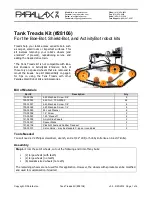
A-27
186638-1CD
186638-1CD
Appendix A
A.1 Glossary
U
GP8 EduCart
Tool Against Tool
Interference is checked by using a cylinder that is slightly larger than the
arm or tool. A sphere is placed on both ends of the cylinder. If the cylinder
and spheres of one manipulator have any contact with those of the other
while moving, the manipulators stop because interference was detected.
Tool Center Point (TCP)
The Tool Center Point (TCP) defines the tip of the current tool as defined
relative to the tool flange. For example, for a welding robot, the TCP will
generally be defined at the tip of the welding gun. After defining and
configuring the TCP, the robot motion will be defined relative to this frame
(i.e., rotation in the Rx direction would cause rotation around the X-axis
and positions will be taught in this frame.
Tool Control Point
See
Tool Coordinates
When the tool attached to the robot moves, so does its tool coordinate
system in reference to a fixed coordinate system, for example, world
coordinates. In general, the tool coordinates do not align with the world
XYZ coordinates.
Tool Frame
A coordinate system attached to the end-effector of a robot (relative to the
base frame).
Touch Sensor
Sensing device, sometimes used with the robot's hand or gripper, which
senses physical contact with an object, thus giving the robot an artificial
sense of touch. The sensors respond to contact forces that arise between
themselves and solid objects.
Trajectory Generation (Calculation)
The computation of motion functions that allow the movement of joints in a smooth
controlled manner.
Transducer
A device that converts energy from one form to another. Generally, a
device that converts an input signal into an output signal of a different
form. It can also be thought of as a device which converts static signals
detected in the environment (such as pressure) into an electrical signal
that is sent to a robot's control system.
U
Uptime
A period of time in which a robot or production line is operating or
available to operate, as opposed to downtime.
User Coordinate Setting
User coordinates are defined by three points that have been taught to the
manipulator through axis operations. These three defining points are
ORG, XX, and XY, as shown in the diagram below. These three points of
positional data are registered in a user coordinate file. ORG is the home
position, and XX is a point on the X-axis. XY is a point on the Y-axis side
of the user coordinates that has been taught, and the directions of Y- and
Z-axes are determined by point XY.
85 of 88
































